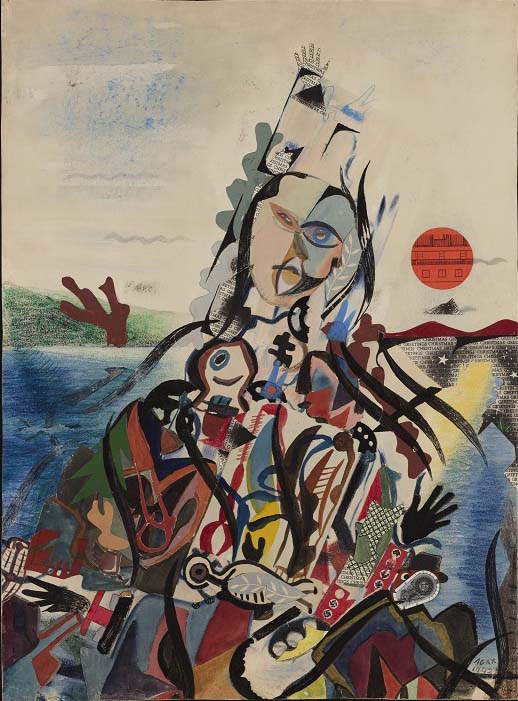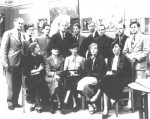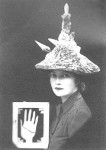

Eileen Agar
British, 1899-1991 (active France, Argentina)
Madonna of the Setting Sun, 1942
collage, ink, watercolor, and crayon
25 3/4 x 19 in., signed
SBMA, London Collectors Group Fund & The Mary & Leigh Block Fund
1987.37.3

Eileen wearing ‘Ceremonial Hat for Eating Bouillabaisse’, c.1936. Photo above right taken at the 'International Surrealist Exhibition', New Burlington Galleries, London, 1936. Standing left to right: Rupert Lee, Ruthven Todd, Salvador Dalí, Paul Eluard, Roland Penrose, Herbert Read, E.L.T. Mesens, George Reavey and Hugh Sykes Williams. Seated left to right: Diana Brinton Lee, Nusch Eluard, Eileen Agar, Sheila Legge and an unidentified friend of Dalí.
She has stated that,
"Abstract art and Surrealism were the two movements that interested me most, and I see nothing incompatible in that, indeed we all walk on two legs, and for me one is abstract, the other surreal - it is point and counterpoint". (Birch & Conran, London, "Eileen Agar at 90 Special Presentation"; Wilson, Andrew , The Spirit of Surrealism, 1989)
She described her own paintings as leaning "towards the beauty or ugliness of the subjective idea or symbol". As Andrew Wilson indicated when he wrote about her work: "Her fluid biomorphic images are often anchored by a classical rigidity or abstract framework".
RESEARCH PAPER
Eileen Agar was born in 1899 in Argentina to wealthy English parents. It is interesting to note that Ms. Agar's birthdate in most articles is stated as 1904. However in a 1989 article, she was asked about her recent birthday. She is quoted as saying, "Yes, I was 90. I was born in 1899 and that makes me 90". One of three girls. She and her family returned to England in 1906 when she was 7 years old. Agar began drawing constantly around age 5. Although her family discourage her interest in art, and sent her to finishing school, She was determinded to become a professional artist and support herself.
In the 1920's after being classically trained she went to Paris were the Surrealist movement was just getting started, and lived in France until the onset of World War II. Having lived in Paris and moved in artistic circles, she was aquainted with Picasso and various avantqarde intellectuals. Her work from the early 30's closely reflected the continental developments at the time. She was an established artist in 1936 and was chosen to exhibit in the International Surrealist Exhibition at the New Burlington Galleries. She was one of the first women members of the original Surrealist group in England.
The "Madonna of the Setting Sun" gives an example of Agar's ability to incorporate classical allusions of the ancient world. For Agar, calling on images from ancient times was a way of releasing emotions. English artist Paul Nash refers to her "element of poetic mystery" and it was this ability, to weave together myth, legend, and nature, which drew the attention of British and French poets and artists to her and her work.
The collage is best viewed from a distance in order to grasp the overall theme. Then approach it more closely to to find the specific details manifesting Christian symbolism. The composition is characterized by thick flowing black lines and ameobic shapes, in varying line weights and colors. The overall outline of the figure is formed through broken lines. These open-ended lines encourage the viewers eyes to move erratically across the image. The sun has an intense neon orange/red value. The other colors are of a medium value and intensity.
Symbols evoking Christian antiquity include the hand, the olive branch, the stars, fish-like shapes, and the sun. In the early days of Christian art, Christians hesitated to depict their God. The Almighty was frequently indicated by a hand issuing from a cloud that hid the awe-inspiring and glorious majesty of God, because no man could behold him and live. The hand raised with palm outward is symbolic of the blessing of God. The olive branch is a true Biblical tree. It yields great quantities of oil, symbolizing the providence of God towards his children. The olive branch is also a token of peace it was carried by the Archangel Gabriel to the Virgin Mary in scenes of the Annunciation. Often it is used by Sienese artists who refused to use the lily, a symbol for the city of Florence, their arch rival. The fish is commonly used as a symbol of Christ. Lighting the darkness of the heavens at night is a symbol of divine guidance of favor. One star is a symbol of the Virgin in her title "Stella Maris" Star of the Sea.
The "Madonna of the Setting Sun" reflects Agar notion of 'womb magic' which she wrote about in 1931, in The Island magazine. A magazine founded by her husband Joseph Bard as a forum of artistic and literary activities. The term 'womb magic' is and underlying metaphor for the subject, and images used in this collage. The floating amoebic, embryonic forms incorporated into a classic image, alludes to the feminine imagination which dominated her work, and gives an unusual twist to a traditional subject. She believed that the developmental forces in her pieces grew slowly like seeds, not unlike the process of creation and life. Andrew Wilson commented how, "Foetal forms that swim across the structured yet watery landscapes in many of her paintings and collages are able to point out how in her case the making of Art is truly about making, creating, giving birth to and forming an image, as opposed to illustrating it." Although the concept of 'womb magic 'gives us an insight to Agars personal philosphy she also was aware of the need to stress the extent to which she used both elements from the abstract and surreal idioms. The collage, like an abstract painting has a rough and spontaneous energy, while also exhibiting the stream of conscious allusions that we consider surrealism.
Today it is easy to see a relationship between surreal and abstract artist. The surrealists were determined to explore the inner world of the psyche, the realm of fantasy and the unconscious as well as to shock and have fun. The abstract artists' works have a look of rough spontaneity and exhibit a refreshing energy. They are intended to be grasped intuitively by the viewer in a state free from structured thinking. Agar was constantly classified as a surrealist. However, surrealism was only one of the two movements that influenced Agar.
Bibliography
Ferguson, George, Signs & Symbols in Christian Art. New York: Oxford University Press, 1959.
Norwich Gallery: Norfolk Institute of Art & Design, "Ten Decades Careers of Ten Women Artist born 1897-1906.
Leeds City Art Galleries, "Surrealism in Britian in the Thirties, Angels of Anarchy and Machines for Making Clouds", Robertson, Alexander, Remy, Michel, Gooding, Mel, Friedman,Terry. 1986.
Birch & Conran, London, "Eileen Agar at 90 Special Presentation"; Wilson, Andrew, The Spirit of Surrealism, von Joel, Mike, A Twentieth Century Artist's Life, 1989.
Ades, Dawn, The Oxford Art journal, Vol., 3, April 1980, pp36-42.
Santa Barbara Museum of Art, " Docent file on Agar, Eileen," 1994.
Prepared for the SBMA Docent Council Michele Yeadon April 1994.

Eileen photographed by Cecil Beaton in 1927.
SBMA CURATORIAL LABELS
Born in Argentina of Scottish-American parents, Eileen Agar had a privileged childhood against which she was later to rebel. Recalling a youthful visit to the studio of the painter Charles Sims, she remembered being struck with wonder at what could be achieved by the simple act of making marks with a stick of bristles on a blank canvas. This was her initiation into the mystery of painting. Later, in 1936, Roland Penrose and Herbert Read selected three paintings and five objects by her for inclusion in the International Surrealist Exhibition. In her autobiography, A Look at My Life, published in 1988, she recorded: “Abstract art and Surrealism were the two movements that interested me most…we all walk on two legs, and for me, one is abstract, the other is surreal – it is point and counterpoint. Surrealism, for me, draws its inspiration from nature.”
In this 1942 work Agar’s juxtaposition of the Madonna with the setting sun probably has political implications reflecting the darkest hours and days of World War II
